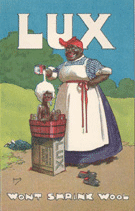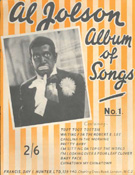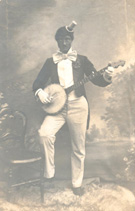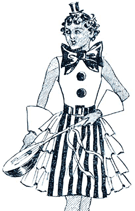
|
Golliwogg.co.uk |
Golliwogg.co.uk
|
|||||||||||
|
What's the matter with Golly? |
|||||||||||
|
The golly emerged at a time, in the late 19th and throughout the first half of the 20th century, when numerous illustrators, food companies and toy manufacturers used exaggerated images of black people to promote their products. These usually came in the format of black skin, enormous eyes, giant lips, and unkempt hair often referred to as 'wool'. Mantha Diawara calls this 'The Blackface Stereotype'. It is a facial description that originated in slavery by the slave owner, most particularly in the USA: 'They [the slave master] would say that during the night, when it was pitch dark, black people would go to the master's field to steal watermelons or, like foxes, to the chicken coop to steal chickens. But supposedly, these black people were always betrayed by their white teeth and white eyes which shone in the dark like lightening. They could not hide, even in the darkest nights, even though they were so black. That was why their smiles were cut like slices of watermelon and they were considered, like chickens, to be cowards'. (Mantha Diawara, The Blackface Stereotype in David Levinthall's Blackface, 1999).
This face was used to represent black people in art works and was generally placed on the bodies of wiry porters and waiters, an oversized mammy (domestic servant), or 'scrawny' children. The face was also referenced in the golly. Critique of such imagery in advertising is based on the imperial quest by the West, that is Europe and the USA, which cast black men, women and children as caricatures and stereotypes, and that their place was an inferior one to that of white people. Contemporary artists have reacted to this image. For example, Sonya Boyce has always found the golly image to be frightening. She is amazed by the level of affection and attachment expressed by white people for this figure. Sonya feels that when one fragments the face of the golly it impacts on the subconscious in relation to how black people have been represented in illustrations and advertisements, films and stories. The style of dress that is associated with the classic golly image is a bow tie, waistcoat, jacket and trousers, usually in bright colours. When this attire is combined with the facial description outlined above, then it is linked directly to the 'Minstrel' figure. This character began amongst slaves who entertained in their masters' houses in the early 19th century. From the 1820s black people were being parodied and ridiculed through this medium, particularly in North America. White Americans 'blacked-up', that is blackened their face and painted the exaggerated mouth they believed belonged to black people. They then performed shows using a broken English ascribed to black people labelled 'negro dialect'. The father of this format of minstrelsy was Thomas Dartmouth Rice (1808-1860). In the 20th century the most famous was Al Jolson (1886-1950). Although minstrelsy was originally intended to be a cultural format against slavery, it became a popular means to encourage slavery and ridicule the dress style and hopes of the urban, free black man, generally referred to as the black dandy. The tailored jacket, waistcoat and slim cut trousers were his trademark. For example, an American minstrel show was presented at the Palace Theatre in London in 1905. The most enduring example in this country is The Black and White Minstrel Show. Launched on the BBC on 14 June 1958, it retained the essential elements of minstrelsy and was an incredibly popular show. In 1964 it achieved its highest viewing figures of 16.5 million. In 1967, the BBC was petitioned by the Campaign Against Racial Discrimination, who asked for the programme to be discontinued due to its 'racial implications'. In spite of this, the programme continued until July 1978. |
|||||||||||



